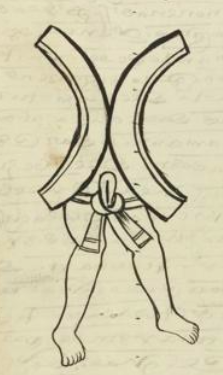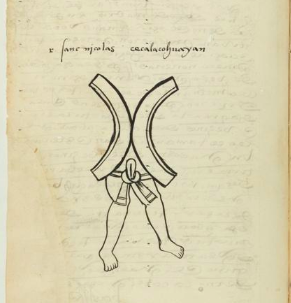Cencalacohuayan (MH590v)
This black-line drawing of the simplex glyph for the personal name Cencalacohuayan (“An Entire Doorway,” attested here as a man’s name) shows a frontal view of the lower half of a standing man's body. He is wearing a loincloth and has bare feet. His upper body is not shown, but in the place of that are two curving elements that are rounded and yet still for something of a large X shape. Perhaps this is meant to convey a doorway or entryway (calacohuayan).
Stephanie Wood
The curving lines are reminiscent of the curving ball court shapes in another glyph from this same manuscript. See the tlachtli below. That particular ball court has some features in common with the glyph for movement (olin). These comparisons raise questions about the translation we have given Cencalacohuayan. Perhaps the Cen- prefix alters the meaning of door or entrance in some significant way that is unclear yet.
Stephanie Wood
Sanc nicolas cecalacohuayan
San Nicolás Cencalacohuayan
Stephanie Wood
1560
Jeff Haskett-Wood
entradas, entryways, doors, puertas, taparrabos, loincloths, standing, a pie, curving, bending, curvar, doblar, cancha de pelota, ballcourts, nombres de lugares

calacohuayan, a door, an entry, https://nahuatl.wired-humanities.org/content/calacohuayan
ce, one, https://nahuatl.wired-humanities.org/content/ce
cen, entirely, https://nahuatl.wired-humanities.org/content/cen
La Entrada Entera, o el Pueblo de Una Entrada Completa
Stephanie Wood
Matrícula de Huexotzinco, folio 590v, https://www.loc.gov/resource/gdcwdl.wdl_15282/?sp=260&st=image
This manuscript is hosted by the Library of Congress and the World Digital Library; used here with the Creative Commons, “Attribution-NonCommercial-ShareAlike 3.0 License” (CC-BY-NC-SAq 3.0).





